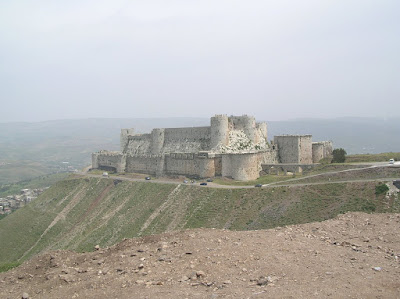
On the way, we stopped at a Greek Orthodox Monastery. Here, we toured the New Church, and then went down into the 'basement' of the Monastery to see the 800-year old Church. I was able to light candles on Good Friday. The Monastery was, yet another unbelieveable sight, built overlooking the green valley.
From Hama we drove out to see Crac Des Chevaliers, the 'epitome of the dream castle of childhood fantasies' as described by author Paul Theroux. 'Lawrence of Arabia" called it 'the finest castle in the world'. The castle was first built in 1031, but it was the Crusader knights who, around the middle of the 12th century, expanded the castle into its exiting form. Although the castle was attacked many times, the castle held firm and was never truly 'breached'. The Crusaders gave it up when there were only 200 people living in the castle with enough provisions for five years, surrounded by the armies of Islam and with no hope of reprieve, they agreed to depart from the castle in return for safe conduct.

Declared by UNESCO to be a world heritage site in 2006:
Crac des Chevaliers and Qal’at Salah El-Din (Syrian Arab Republic). The two castles represent the most significant examples illustrating the exchange of influences and documenting the evolution of fortified architecture in the Near East during the time of the Crusades (11th to 13th century). The Crac des Chevaliers was built by the Hospitaller Order of Saint John of Jerusalem from 1142 to 1271. With further construction by the Mamluks in the late 13th century, it ranks among the best-preserved examples of the Crusade castles. It is an archetype of the medieval castle, particularly of the military orders and includes eight round towers built by the Hospitallers and a massive square tower added by the Mamluks. Similarly, the Qal’at Salah El-Din (Fortress of Saladin), even though partly in ruins, still represents an outstanding example of this type of fortification, both in terms of the quality of construction and the survival of historical stratigraphy. It retains features from its Byzantine beginnings in the 10th century, the Frankish transformations in the late 12th century and fortifications added by the Ayyubids dynasty (late 12th to mid-13th century).

We drove out from Hama to see Crac Des Chevaliers.
The castle was unbelieveable. The outside wall had 13 towers and the main entrance.

The inside wall and the central construction, built on a rocky platform. The angle of the slope is such that archers firing from the rounded bastion had a clear line of fire at any point. There was literally nowhere for an attacker to hide.

A moat dug out of the rock separates the two walls. We walked through the baths and the great hall to three towers on the southern wall.

Wikipedia says:
The Crac des Chevaliers (an Arabic/French combination meaning "Castle of the Knights") was built at Qal'at al-Hisn by the Knights of St John, who occupied it from 1142 until 1271 when it fell to the great Mamluk leader Sultan Baybars. At it's peak, the garrison at the Crac consisted of over 2000 men and it's extensive underground storerooms could have held provision enough for very long sieges. The young T.E. Lawrence, long before he aquired the "of Arabia" epithet, visited the Crac as part of his undergraduate studies of medieval military architecture. He described it as being "...undoubtably the most impressive fortress in the world." Whilst it lacks the grandeur or scale of the great Moghul castle of Rajasthan it has instead a kind of uncompromising integrity not unlike some of the finer examples of neobrutalist architecture in 20th century europe. This was not a castle designed for comfort or pomp - it was simply the quintessence of defensive military engineering and even now, almost 900 years later, it still stands defiant, ready to take on all comers.
Then we continued around the wall and entered the inner fortress through the tower at the top of the access ramp into an open courtyard together with three classes of (Grade 5/6, perhaps) students and volunteer parents accompanying them.

In the courtyard there was a loggia, with its Gothic facade on the western side of the yard. It is the most impressive structure in the castle.

Opposite the loggia is a chapel that was converted to a mosque after the Muslim conquest.
Leaving the windy area of the Crac Des Chevalers, we returned to Hama around 3:30 p.m. becoming aware of the some 35 degree weather of the day. Most stores were closed and the town was quiet.
We decided to venture out and find a place to eat supper. As we walked further away from our hotel and it became later, the town came alive again. We walked around past a Greek Orthodox church, having an Easter Service with many, many people. We could hear the drums of the Easter Procession (as in Spain) in the background.

Near the Church, we found a 'family restaurant' with an outdoor courtyard. It was empty and the waiter seated us down at the back of the restaurant. As we commented, how strange it was to have the entire restaurant (some 100ft by 50ft) to ourselves and what an experience it was, it began to fill up with families and teenagers and young adults. Within minutes it was very crowded with the waiters bringing in additional tables to set for people.
At the table next to us, a young girl, some 10/11 years old began practising her English with us, with her family's encouragement. She then pinned a cross on myself and Gerald, as a souvenir of Good Friday in Syria.
This morning, we left for Damascus and arrived here by bus around 11:00 a.m. Back in Damascus, we have our favourite internet cafe and places to visit again.























